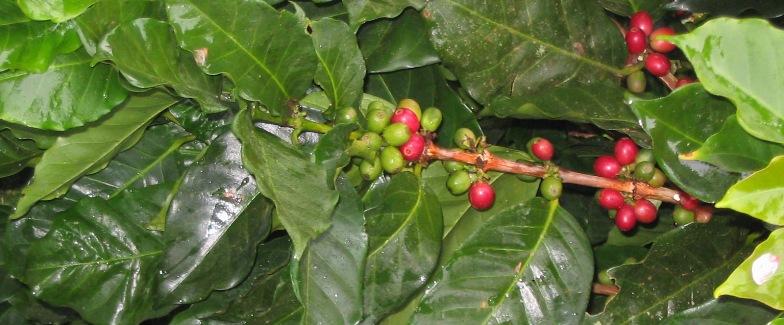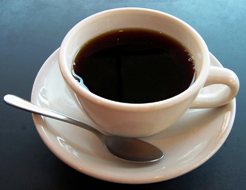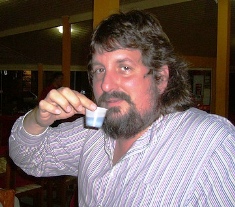
The hero of
the Adam@Home
comic is starting to take
his coffee very seriously!
Thanks to cartoonists Brian Basset and Rob Harrell for
spreading the word on coffee care.
I am proud to be a member of the Barista
Guild of America, a division of the Specialty Coffee
Association of America (SCAA),
which is the trade association for the premium coffee
industry. See its brewing
page for an overview of key considerations or to buy a
printed brewing guide.
Equal Exchange is a leader in fair-trade coffee. It was from
Rodney North of EE that I took a coffee-tasting seminar and
first started to understand the connection between the field
and the cup. When someone compliments me on a well-prepared
cup of coffee, I always answer, "Thank the farmers!" Like
Rodney, I see what I do in my kitchen as simply a way to
honor their hard work and attention to quality. It was also
from Rodney that I learned to think of coffee as a series of
about 52 steps. Decisions made at each step -- even down to
pouring the coffee -- can make a difference in the tasting
experience! See EE's brewing
tips page for guidance on coffee preparation or the coffee
brewing page on Coffee Research.
Coffee is 98 percent water, and coffee tends to magnify any
flavor defects in the coffee. A good cup, therefore, starts
with cool, filtered water. I avoid bottled water because it
is expensive and bad for the planet. Distilled water, by the
way, is too pure.
Without any minerals, it makes coffee that tastes flat. See
the Brita-sponsored FilterForGood
site for ideas on good water and the evils of bottled water!
I drink my coffee free of condiments, unless I am faced with
problematic coffee of some kind. If the coffee does not
stand on its own, I probably will not drink it. For many
consumers, however, coffee has essentially become a base for
sugared or flavored creamer. Pamela Hayes-Bohanan has a nice
page describing our small role in
coffee marketing history. Years before we realized
that I would become a bit of a coffee fanatic, we were
participants in research that Folger's (yes-- ugh! --
Folger's) conducted on coffee condiments for young
adults.
Counter Culture Coffee has produced a video
of a barista competition that shows how a connection the
farmers can make a difference in professional coffee
preparation.
The
Italian
coffee company Lavazza's has a training page that
provides advice on the preparation of coffee from a European
perspective. The page reveals how differently coffee is
viewed in Italy, where a big mug of coffee is unheard of,
and where decaf is viewed with great suspicion. I was
thrilled to meet with Lavazza's corporate trainer in New
York City in April 2005. From Sal, I first started to
realize how much I still need to learn about coffee! Lavazza
is at the high end of conventional coffees, but is not a
specialty roaster. As we say in our house, "Sal has ruined
me" for bad coffee.
These days (2011 and 2012), the most common question I get
about coffee is not about the coffee itself, but about a
brewing machine that has become the industry's greatest
money-maker, and its greatest threat. I have mixed feelings
about the Keurig, mainly because it is owned by a roaster --
Green Mountain Coffee Roasters -- that I know for its
quality coffees and positive relationships with some of my
favorite growers. Also, I used to work in specialty food
packaging, and I find the technology fascinating. Still, I
have to come down as an opponent of these ubiquitous
machines for several reasons, which are detailed on the Will
Convenience Kill Coffee? post on my Environmental
Geography blog. I am particularly opposed to their
proliferation in my own building, where my university has so
far refused to open a world-class coffee shop, and
hard-working employees see the Keurig as their most
convenient alternative, as bad as it is for the environment
... and the coffee. For those who have already become
accustomed too the convenience -- real or imagined -- of the
Keurig, blogger Gizmodo offers several other quick
coffee alternatives, most of which are cheaper.

|

Be sure to turn on the
captions.
Note: Unlike the rest
of my Flickr photos, some of the images in this set are
not my own. Several are stock photos from equipment
sellers or other sources.
By popular demand, here is the short version
of the ten steps we follow at home. I recommend starting
with these parameters and adjusting to taste.
- Choose really good, recently roasted coffee beans
- Start boiling cool, filtered water.
- "Measure" coffee -- too much is better than too little
- Grind coffee with a burr grinder, set to coarse
- Let water cool for two minutes after boiling -- the
goal is 205 degrees F
- Put the coffee in the bottom of French press and mix
with handle of a wooden spoon (metal will scratch the
press)
- Put top on press and wrap it in a kitchen towel
(unless the kitchen is very warm). Set timer for 5
minutes.
- Put ceramic mugs on or near the turned-off burner. If
cream or sugar is being used, it is placed in the cup to
warm
- Pour and enjoy.
- Thank the farmers!
Above is our weekday
routine. On weekends, or if really special coffee is on
hand, we now use a vacuum press. I had wondered about
these for years, and now I know what all the fuss is
about. I describe this particular ritual as part of my Franksgiving
post on Nueva Receta.
|


